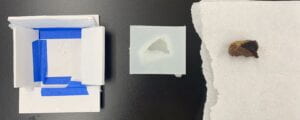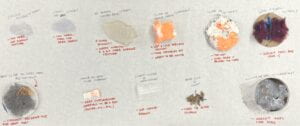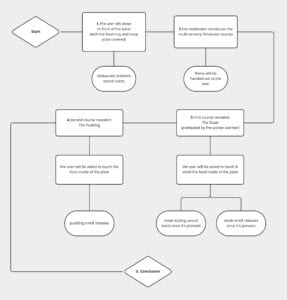Project- Tom, Shauna, Vera, Q
Omakase
Designers
- Tom Xia
- Shauna Wu
- Vera Zhong
- Queenie Huang
Project Description
Omakase is an unusual dining experience where you are served a plate of visually ambiguous food to explore without tasting. It aims to challenge our regular dining experiences by diverting the expectation of visual and gustatory qualities of food to acknowledge and enhance the presence of other senses in our daily activities.
The experience begins as users are given a menu that explains the project and informs them of the two dishes they will be served. Then they are served their first ‘empty’ plate, a dish that does not visually resemble a piece of steak. They are to explore with their hands the texture of the plate, listen to the sound of the food and restaurant, and smell the fragrant scent of perfectly cooked meat. They are then served the dessert– the pudding where they will be asked to do the same explorations before the experience concludes. Putting aside taste, as we live in a heavily ocularcentric culture, more and more effort has been placed in perfecting the visual qualities of a meal, especially due to the presence of social media. So instead of designing something that acts as a tool to enhance the dining experience, we wanted one that prompts users to reevaluate their existing habits and begin to notice the many other elements involved that enriches their day to day activity of eating.
Timeline
- 10/27/2022: Settled on the project idea
- 11/03/2022: Prototyping form and materials
- 11/10/2022: Initial user testings > determined direction of improvement
- 11/17/2022: Determined the final materials and food selection
- 12/01/2022: Completed the finalized version of the experience
Weekly Updates
10/27/22
OBSERVATION & IDEATION

The visual representation of food is usually very important in the dining experience as it enriches our perception and memory of the food. But what would a meal be like without visual content? We are interested in diverting the expectation of food we would normally have in the dining experience by taking away the visual part and emphasizing other senses like the smell, sound and haptic experience. Artist Teresa Berger’s Tableware collection not only uses different materials on the plates and bowls but also introduces sound as part of the sensory functions with the food still as the protagonist. While the synthetic muscle from Shanghai 3D Printing Cultural Museum has an analogous appearance to real meat, it is actually made out of colored silicone. Taking from these projects, we want our project to be an experiment on how we can accentuate other sensory experiences with food.
11/03/22
RAPID PROTOTYPING

For week 2, we first did a quick cardboard prototype of the plate’s form that would allow us to test out different material’s texture efficiently. The dip would allow us to have sensors and speakers later on for the sound, but for now we were testing the tactile aspects of food. We tried things like shredded cork to emulate meat paddies, and steel sponges for a softer, fluffy dessert experience. In addition, we wanted to see if silicone casting could capture the surface texture of steaks while retaining a certain level of elasticity.
11/10/22
USER FEEDBACK
From our user testing, we tested with five randomly selected individuals who were present on the ITP floor. The aim of our study was to see if the users were able to correctly identify the types of food based on our prototypes, see what the materials remind the users of, and if this experience would change the users’ dining experience. We asked users to touch our materials with plates covered and uncovered and asked several follow up questions regarding what each prototype felt like and what other sensory elements would help better identify the item. Based on the answers of our participants, we have collected some general consensus from main issues and area for improvement:
- Temperature affected the experience significantly: most users did not associate the prototypes with food because it wasn’t hot, whereas the dessert was easier because it is originally cold
- The meat texture could be further emphasized with more defined fibers and ridges, with just the stiff surface texture, users felt it was most like dried food
- Smell is also a component that was mentioned as an additional sensory element that would affect the experience, which we did not include in this iteration of the user test.
- Having too many different textures in our second prototype appears to throw people off without being able to see
- One interesting feedback was if there was a bit more contextual and environmental cues such as having them imagine themselves at a fine restaurant etc…
- regarding the sound.. since the sizzling wasn’t clear enough and the sound wasn’t coming from the food/plate itself, it also seemed to throw users off instead of aiding in imagining the dining experience
For our next steps, we are thinking about utilizing a heating pad to manipulate the temperature of our food replicas as well as work out the scent component (i.e. fragrance oils, wax, diffusers). We will also look into providing more details and context to the experience itself, experimenting with how we would want to present each item to set expectations for users.
11/17/22
ITERATION

Having tested various materials ranging from casted silicone, dried hot glue, cork, foam…etc. we have decided that for our final materials we will recreate steak with a 3D printed flexible resin for the steak and slime on foam for the pudding with smell from oil and vanilla fragrances. In order to better craft the environmental context, we will be using actual ceramic plates on a placemat with utensils while playing an ambient sound of restaurant setting.
5 W’s Chart
Source: Velasco, Carlos and Marianna Obrist. Multisensory Experiences. 2020.
| Components | Questions and considerations |
| Background (Why) | Why do we want to design this interface?
We want to see whether or not we can accentuate a regular dining experience by raising users’ awareness of other senses that are present. This is done by diverting the expectations of users through eliminating or altering the visual and taste senses*, allowing them to focus on the other sensory experiences. *It is not that they cannot see or taste, but that there is nothing to see and taste. |
| Impressions (What) | What impressions do we want the user to feel when interacting with the interface?
Familiar yet unexpected reactions towards the served plates. It is supposed to make them reconsider their previous dining experiences and realize the senses they disregarded/ |
| Events (When) | What is the user’s journey?
The user would be presented with a plate of visually unidentifiable “food” which they would not be able to taste. The users would be prompted to touch the plates, hear |
| Sensory Elements (How) | What sensory modalities should we select and why? Are there trade-offs? Who might be excluded?
Taking out the taste of the food and focus on sight: an ’empty’ plate (content is ambiguous) Touch: to feel the texture of food Sound: to render the contextual experience Smell: to evoke the memories of the actual food |
| Receiver (Who) | For who are we designing?
No specific group of targeted audience but is aimed for people who are interested in exploring and expanding their dining experience. |
System Diagram

Code
Click here for the code used for the plate of steak.
Sources
Inspiration project by Teresa Berger
Final Presentation